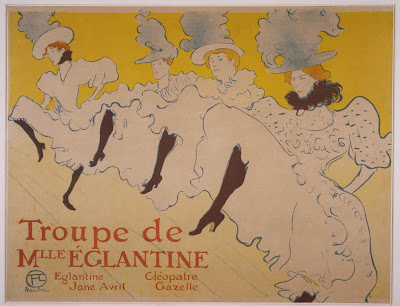Take this section for instance - “HOW TO MAKE CHICKEN TENDER Poulets a devenir tendres - In order to make chickens immediately edible, take them out of the hen-run, pursue them into open country, and when you have made them run, kill them with a gun loaded with very small shot. The meat of the chicken, gripped with fright, will become tender. This method used in the country of the Fangs (Gabon) seems infallible even for the oldest and toughest hens”. If you think de Toulouse-Lautrec has substance in his recommendations for chicken tenderising and you intend to follow his advice it would be wise to keep quiet about it. It seems hard to imagine one of Birmingham’s famous chefs pursuing a knackered old chicken down Cornwall Street or Waterloo Street or through the Jewellery Quarter to render its flesh more tender.
Some illustrations from the book:-
 |
| Frontispiece showing a Painting of T-L (at his oven) at Misia and Thadée Natanson’s at Villeneuve-sur-Yonne by Eduard Vuillard, 1898 |
It occurred to me that it might be nice to track down any T-L art in Birmingham and search out anything food-related and even if it weren’t at least come face-to-face with some of his joyous works in the flesh. Of course, it still being the time of Lockdown that was not something that was immediately doable (just like sitting down in Purnell’s to his witty dishes is still not doable). A trail of the internet was not very promising and I have only come up with three pieces of his work in Birmingham’s galleries. In Birmingham Art gallery and Museum there seems to be only one piece - Troupe Della Mlle Églantine which has nothing to do with food. I can’t quite see these young ladies showing a leg while diners sit eating their amuses bouches in the formality of Adam’s. I would have thought Adam’s was more pre-Raphaelite than gay Paree.
The internet suggests that there are 2 T-L works at the fabulous Barber Institute in Edgbaston. Alas again not food-related in subject. Firstly there is A Woman seated in a garden (c.1890)which might do very well for Simpsons.
And secondly there is Le Divan Japonais (1892) which might sit well in one of Birmingham’s cocktail bars and Gingers Bar feels rather suitable considering the appearance of the lady in the picture.
Finally one must think that The Wilderness is definitely more Goya than Lautrec.
I think that vibrant numbered and signed printed menus by suitable local artists, their style to match the restaurant, served with meals, perhaps on special evenings if the expense is rather great, could be a great draw to bringing the fearful back to our restaurants once they are allowed to reopen. It could open up a new collectors’ market.
It’s worth recalling that in the mid-20teens, Birmingham did indeed have a restaurant which attempted, to a limited extent, to recall the Parisian restaurants of the Belle Époque. The large restaurant at the far end of Corporation Street where one turns the corner into Steelhouse Lane was named Annexe and looked rather smaller as one walked past it. The location was awful with very little passing trade except, I suppose, from persons having business with the nearby Victoria Law Courts. The restaurant was also graced by employing one or two staff who thought that they were Parisian waiters and treated their customers with the appropriate degree of disdain and condescension. The food was expensive with nothing innovative about it which at least would have made the high prices demanded for shockingly small helpings of food more defensible. The interior was rather dark and gloomy and had nothing to do with the bright scenes depicted in the work of Toulouse-Lautrec. Special event evenings were held including the showing of classic French movies - that much at least was innovative and imaginative - and these, for a while at least, made the restaurant wildly popular avec Les Tripadviseurs of Birmingham who rated it the number 1 restaurant in Birmingham until they probably became fed up of leaving the restaurant hungry despite having paid a large bill and having the experience of being treated with contempt by the waiters. Perhaps they thought that they were being given the genuine French expérience.
Annexe closed in July 2017 with the management announcing that their landlords, the owners of Central Hall, wanted to sell the entire building containing the restaurant. Before closing the restaurant did host a Bastille Day celebration.
Apart from my first visit, when I noticed the restaurant as I was passing (probably the only passing trade it ever got), I sat at a table on the pavement outside downing a small quantity of some extravagantly priced but admittedly tasty onion soup with an equally small amount of bread (a table at nether-Corporation Street alas does not mimic Montmartre sufficiently) I visited Annex only one more time for a mid-week dinner - it seemed to be struggling to attract customers but that had had no effect on the chef’s inability to provide an adequate plate of food or the front of house staff to behave vaguely politely. It seemed likely that it was a restaurant with a limited life expectancy. Pity it could have been a great hit but it’s poor location and tight-fisted and ungracious approach to its customers ensured its doom.








No comments:
Post a Comment